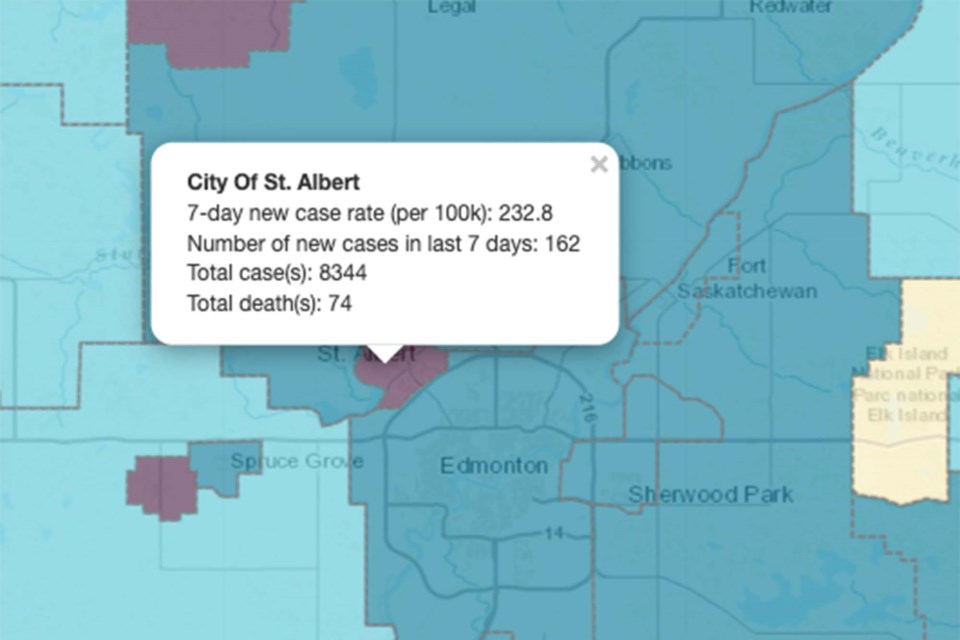COVID-19 cases in St. Albert have increased slightly this week, according to data from the province released on Wednesday.
The seven-day case rate per 100,000 was 232.8, according to data gathered by the province from April 19-25, an increase from the 217 reported last week.
St. Albert had 162 new cases over the seven-day period, a slight increase from the 151 cases reported on April 20.
One more St. Albert resident has died from the virus. The total number of St. Albert residents who have died from COVID, to date, is 74.
Sturgeon County's seven-day case rate was 154, compared to the 121.7 reported on April 20 — also a slight increase. The province reported 43 new cases in the county, compared to the 34 reported last week.
The total number of people who have died from the virus in Sturgeon County remains at 18.
Morinville saw a decrease in COVID cases from April 19-25. The seven-day new case rate per 100,000 was 140.2, compared to the 201.5 per 100,000 reported on April 20.
The total number of new cases was 16, as reported by the province on April 27. Last week, the province reported 23 new cases.
There have been no new COVID deaths in Morinville. The total number of residents who have died from the virus remains at 15.
Health Minister Jason Copping said during a COVID-19 update on April 27 that the province is seeing signs of slowing transmission as teams monitor all the available data, including wastewater surveillance, PCR test positivity, and hospital admissions.
“Over the past week, our average positivity rate is 25.7 per cent. That's lower than most of the past month, and signals that we may be plateauing,” said Copping.
Copping said wastewater signals remain high at many sites throughout the province, but there has been a decline or plateau in Edmonton, Red Deer, Canmore, Banff, and Grande Prairie.
“The surrounding communities in the capital region are seeing a much slower increase than in the initial Omicron wave,” he said.
Copping said hospitalizations have risen by eight per cent in the province. Data from the province showed 1,220 COVID hospitalizations, compared to 1,126 reported last week. The number of people in ICU has risen to 47, compared to the 43 reported last week.
“We're now about five weeks into a BA.2-driven surge in transmission, and we can see that the impact is much less than the initial Omicron wave, especially when it comes to hospital admissions,” he said.
Copping said hospitals remain under significant pressure, however the current COVID admissions are not driving the same capacity challenges as was seen in previous waves.
Copping said strain in hospitals is not new. Historically, hospitals across the country have run at 90 per cent occupancy and higher, especially in big cities at peak times.
“What we have not seen before is two years of continuous pressure and stress on the workforce from the pandemic, including those workers who are sick with COVID. We need to add capacity, we need to get through the current surge of COVID cases. But we also need to do more than just get back to normal,” he said.
Dr. Deena Hinshaw, Alberta's chief medical officer of health, spoke about questions she has received regarding reported cases of severe hepatitis or liver inflammation in children in mostly European Countries and the United States.
Hinshaw said there have been 170 cases globally of sudden liver inflammation in children under age 16. Of those, 17 have needed liver transplants, and one child has died.
“There are many causes for hepatitis, but in these cases, the most common causes have been ruled out and it is not clear what led to the condition,” she said.
Hinshaw said some cases had adenovirus, a common cold virus, in common.
To date, there have been no confirmed cases in Alberta. Hinshaw stressed that this is a very rare condition.
“If there is an infectious cause of the syndrome, the same things we have been doing as parents over the last two years will still be valuable now,” she said.
Remind your kids to clean their hands regularly, stay home when feeling ill, and use masks in public spaces for extra protection, she said.




